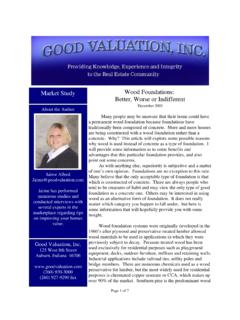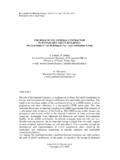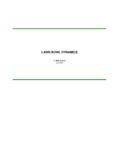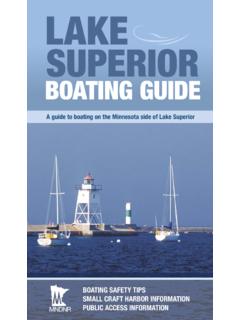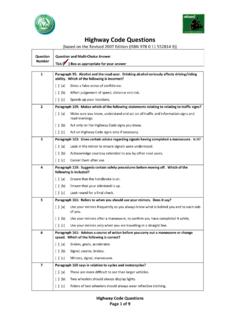Transcription of SECTION 1: PRODUCT AND COMPANY …
1 SECTION 1: PRODUCT AND COMPANY identification PRODUCT NAME: 1250 Ink SYNONYMS: Mark II Stamp Pad Ink COLORS: Black, Blue, Red, green , Brown and all other dye based colors MANUFACTURER: Specialty Ink COMPANY , Inc. ADDRESS: 20 Dunton Avenue Deer Park, NY 11729 EMERGENCY PHONE: 800-688-4005 - VEOLIA OTHER CALLS: 631-586-3666 FAX PHONE: 631-586-3666 PREPARED BY: Keith Werwa SECTION 2: COMPOSITION/INFORMATION ON INGREDIENTS Ingredient CAS NO. % VOL SARA 313 Reportable Exposure Limit Exposure Limit ACGIH-TLV OSHA PEL Ethyl Alcohol 64-17-5 18 1000 ppm 1000 ppm Methyl Cellosolve 109-86-4 37 Yes 5 ppm 25 ppm Diacetone Alcohol
2 123-42-2 25 50 ppm 50 ppm SECTION 3: HAZARDS identification EMERGENCY OVERVIEW: Do not get in eyes, on skin or clothing. Do not breathe vapor or mist. Keep container closed. Use only with adequate ventilation. Wash thoroughly after handling. ROUTES OF ENTRY: Dermal contact. Eye contact. Inhalation. Ingestion. POTENTIAL ACCUTE HEALTH EFFECTS EYES: Irritation to eyes SKIN: Irritation to skin INGESTION: May cause nausea and or vomitting INHALATION: May be toxic by inhalation.
3 Irritation to the respiratory system. SECTION 4: FIRST AID MEASURES EYES: Affected individual should remove contact lens, if present. In case of contact with eyes, rinse immediately with plenty of water or saline solution. Get medical attention if irritation occurs. SKIN: In case of contact, immediately flush skin with plenty of water for at least 15 minutes while removing contaminated clothing and shoes. Wash clothing before reuse. Thoroughly clean shoes before reuse. Get medical attention if irritation occurs. INGESTION: Do NOT induce vomiting unless directed to do so by medical personnel. Never give anything by mouth to an unconscious person. Get medical attention immediately INHALATION: If inhaled, remove to fresh air.
4 Get medical attention if symptoms appear. If exposed person is not breathing, give artificial respiration or oxygen applied by trained personnel. SECTION 5: FIRE-FIGHTING MEASURES FLAMMABLE LIMITS IN AIR, UPPER: (% BY VOLUME) LOWER: FLASH POINT: 102 F METHOD USED: Closed cup AUTOIGNITION TEMPERATURE: 545 F HMIS HAZARD CLASSIFICATION HEALTH: 2 FLAMMABILITY: 2 REACTIVITY: 0 PROTECTION: B EXTINGUISHING MEDIA: Carbon dioxide. Dry chemical. Alcohol Foam. Water spray. SPECIAL FIRE FIGHTING PROCEDURES: Firefighters should wear appropriate protective equipment and self contained breathing apparatus (SCBA) with a full facepiece operated in positive pressure mode.
5 SECTION 5 NOTES: Avoid heat, sparks and open flame. Slightly flammable to flammable in presence of heat. Use an extinguishing agent suitable for surrounding fires . SECTION 6: ACCIDENTAL RELEASE MEASURES ACCIDENTAL RELEASE MEASURES: Keep unnecessary personnel away. Use suitable protective equipment ( SECTION 8). Remove sources of ignition. Ventilate. ENVIRONMENTAL PRECAUTIONS: Avoid dispersal of spilled material and runoff and contact with soil, waterways, drains and sewers. METHODS FOR CLEANING UP: Small spill and leak: Absorb with an inert material and place in an appropriate waste disposal container. Large spill and leak: Contain and cover spill with an absorbent material. Collect and dispose in chemical waste drum.
6 Use appropriate containment to avoid environmental contamination. Place spilled material in an appropriate container for disposal. SECTION 7: HANDLING AND STORAGE HANDLING: Do not ingest. Do not get in eyes, on skin or on clothing. Keep container closed. Use only with adequate ventilation. Do not breathe vapor or mist. Wash thoroughly after handling. STORAGE: Keep container tightly closed. Keep container in a cool, well ventilated area. STORAGE TEMPERATURE: 40-80 F SHELF LIFE: 12 months from date of manufacture SECTION 8: EXPOSURE CONTROLS/PERSONAL PROTECTION ENGINEERING CONTROLS: Provide exhaust ventilation or other engineering controls to keep the airborne concentrations of vapors below their respective occupational exposure limits.
7 Ensure that eyewash stations and safety showers are proximal to the work-station location PERSONAL PROTECTION: RESPIRATORY PROTECTION: Use a properly fitted, air-purifying or air-fed respirator complying with an approved standard if a risk assessment indicates this is necessary. Respirator selection must be based on known or anticipated exposure levels, the hazards of the PRODUCT and the safe working limits of the selected respirator. EYE PROTECTION: Safety eyewear complying with an approved standard should be use when a risk assessment indicates this is necessary to avoid exposure to liquid splashes, mists or dusts. SKIN PROTECTION: Personal protective equipment for the body should be selected based on the task being performed and the risks involved and should be approved by a specialist before handling this PRODUCT .
8 PERSONAL PROTECTION IN CASE OF LARGE SPILL: Splash goggles. Full suit. Boots. Gloves. Suggested protective clothing might not be sufficient; consult a specialist BEFORE handling this PRODUCT . EXPOSURE GUIDELINES: See SECTION 2 SECTION 9: PHYSICAL AND CHEMICAL PROPERTIES PHYSICAL STATE AND APPEARANCE: Liquid ODOR: Mild BOILING POINT: 256 F MELTING POINT: -121 F VAPOR PRESSURE (mmHg): 6 VAPOR DENSITY (AIR = 1): SPECIFIC GRAVITY (H2O = 1): .9663 REACTIVITY IN WATER: None SOLUBILITY IN WATER: Insoluble SECTION 10: STABILITY AND REACTIVITY STABILITY: Stable CONDITIONS TO AVOID (STABILITY): Heat, sparks and open flame INCOMPATIBILITY (MATERIAL TO AVOID): Strong oxidizing agents HAZARDOUS DECOMPOSITION OR BY-PRODUCTS: Burning may produce CO and CO2 HAZARDOUS POLYMERIZATION: Will not occur CONDITIONS TO AVOID (POLYMERIZATION): None SECTION 11: TOXICOLOGICAL INFORMATION METHYL CELLOSOLVE TOXICOLOGICAL INFORMATION.
9 Oral rat LD50: ; inhalation rat LC50: 1500 ppm/7H; skin rabbit LD50: g/kg. DIACETONE ALCOHOL TOXICOLOGICAL INFORMATION: Oral rat LD50> 2000mg/kg; inhalation rat LC50 greater than near saturated vapour concentration/ 1H, dermal rabbit LD50> 2000mg/kg ETHYL ALCOHOL TOXICOLOGICAL INFORMATION: Oral rat LD50: 5800mg/kg; inhalation rat LC50: 16000 mg/l Effects of chronic exposure: Skin and eye irritant. Injury to liver and kidneys. SECTION 12: ECOLOGICAL INFORMATION ENVIRONMENTAL TOXICITY METHYL CELLOSOLVE: Rainbow Trout (Salmo gairdneri) 96 hr. LC 50: = 16000 mg/l (nominal, static) Bluegill 96 hr. LC 50: > 10000 mg/l (nominal, static) Daphnia magna 24 hr LC50: > 10000 mg/l (nominal, static) Brine Shrimp 24 hr LC50: > 10000 mg/l (nominal, static) ETHYL ALCOHOL: Fish:Fathead Minnow 96 hr.
10 LC 50: 15300 mg/l DIACETONE ALCOHOL: Fish: LC/EC/IC50 > 100 mg/l Aquatic Invertabrates: LC/EC/IC50 > 1000 mg/l Aquatic Plants: LC/EC/IC50 > 1000 mg/l SECTION 13: DISPOSAL CONSIDERATIONS WASTE DISPOSAL METHOD: Whatever cannot be saved for recovery or recycling should be handled as hazardous waste and sent to a RCRA approved incinerator or disposed in a RCRA approved waste facility. Processing, use or contamination of this PRODUCT may change the waste management options. State and local disposal regulations may differ from federal disposal regulations. The user of this material has the responsibility to dispose of container and unused contents in accordance with federal, state and local requirements.

